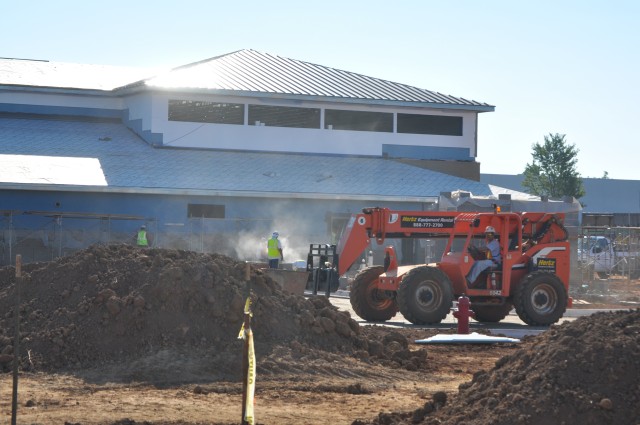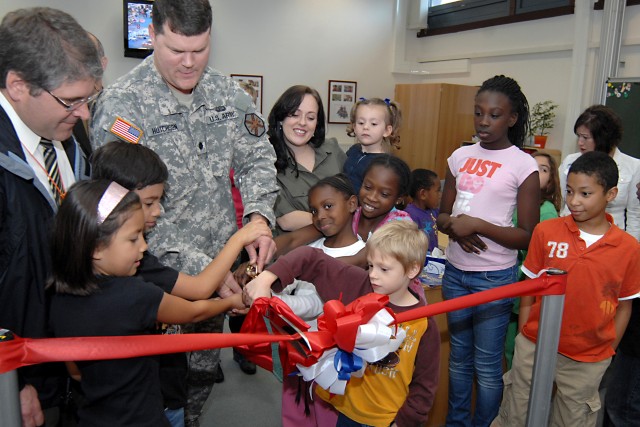Although there was a mini boom of construction during the 80s, over the past four fiscal years the Army's Child, Youth and School Services experienced an unprecedented surge in construction, resulting in increased access to modern, affordable child development centers for Army Families around the world.
"We've never done anything of this magnitude," said Peggy Hinson, CYSS director with the Army's Family, Morale, Welfare and Recreation Command. "This is a direct result of Army senior leaders' commitment to Families."
Over the past four years, construction on Army garrisons has been non-stop. Twenty-two child care facilities were built in 2007, 72 in 2008 and 56 in 2009, with several more in the planning stages for FY12 and beyond.
On-post expansion has also included the renovation of existing facilities to maximize spaces, and the introduction of innovative programs like Youth Check-In Homes and Neighborhood Activity Homes to provide spaces and care for 11- to 15-year-olds outside of traditional facilities.
"We've also constructed a number of new youth centers, with one in 2007, 18 in 2008 and five in 2009," said Hinson.
"We've expanded our facility designs to include mini child development centers. These facilities can accommodate 20 children and will be open 24-hours-a-day, seven-days-a-week," Hinson added. "They will be located at garrisons where there's a major medical center and a potential need for overnight child care for the children of shift workers, or those working extended hours in support of the mission."
The hiring of CYSS staff, to include teachers, caregivers, kitchen staff, custodians and management personnel, is also at an all-time high to accommodate the growing number of Army child and youth facilities.
CYSS has consistently proven to be a contributing factor in encouraging Soldiers to remain in the military. The program gives Soldiers peace of mind, allowing them to concentrate on the mission because they know their children are safe and supervised by trained and professional staff, and provided access to quality child developmental programs. CYSS also works with schools to mitigate the relocation and deployment challenges facing Army Families.
The quality of care and services does not go unnoticed by Soldiers and Families. In the most recent Survey of Army Families, 80 percent or more of those polled said that Army CYSS programs at their installations provide positive growth and development opportunities for their children, and allow parents to better concentrate on their jobs. Just as importantly, respondents said the programs play a role in influencing Soldiers' decisions to remain in the Army.
It's not just young Families with newborns driving these changes. CYSS is aggressively expanding services off-post to support geographically dispersed active-duty, Guard and Reserve Families, and is providing more programs for school-age youth.
Off-post expansion for active, Guard and Reserve Families includes Military Child Care in Your Neighborhood, a child care program that meets the mission needs of Army Families who are geographically dispersed and/or live beyond a reasonable commuting distance of a military base. In addition, Army Child Care in Your Neighborhood, provides similar services near installations to accommodate local population increases.
For school-age youth, including those of National Guard and Reserve Families, CYSS has also developed Army School-Age Programs in Your Neighborhood and Army Youth Programs in Your Neighborhood. These programs reduce the high costs associated with child care for geographically dispersed Families, while at the same time connecting Families with quality, nationally accredited care. The fees are generally comparable to those paid on-post.
CYSS also partners with a number of national civilian organizations such as 4-H, the American Legion, Boys & Girls Clubs of America, CHARACTER COUNTS!, the Military Child Education Coalition, the National Association of Child Care Resource and Referral Agencies, Operation: Military Kids, and other organizations in local communities to deliver quality education programs to children of deployed Soldiers.
On post, the focus on teen support is growing, in part, thanks to teen involvement.
"Army teens have played an active role in helping to design our youth centers," said Hinson. "We want to give them what they will use, and based on their input, we have developed demonstration kitchens where they can learn to cook, video gaming areas, climbing walls and unique art areas," said Hinson.
"We even have sound mixing booths where students can create their own music. Family members are actually surprised when they learn of the quality of our equipment," said Janet Taitano, a CYS services specialist who is part of the furniture, fixtures and equipment set-up team.
"From the time the garrison requests a new CYSS facility, we have a series of kickoff meetings, known as a design charrette," said Richard Miller, also a CYS services specialist and member of the FF&E set-up team. The word charrette refers to any collaborative session in which a group of designers drafts a solution to a design problem. They serve as a way of quickly generating a design, while integrating the aptitudes and interests of a diverse group of people.
"This is a coordinated, multi-faceted approach where the architect; interior designer; health, fire and safety (personnel); and financial management professionals-in short, everyone involved with the construction-come together to develop and present their plans," Miller said.
"This is a turn-key operation, meaning that all the staff and students have to do is turn the key and walk in. When we leave, the (facility) is at least 95 percent ready," he continued.
The Army has come a long way in a comparatively short amount of time, and is working to ensure the newly constructed facilities are aesthetically pleasing while staying within the construction and budget parameters of standard designs.
"We're very proud of how our dollars and time are spent by buying equipment in bulk across the Army," said Nancy Dunn, a CYS program specialist who serves as the contracting officer's representative for the enterprise procurement of FF&E for CYS facilities. "We do quality control on all of the products we buy. Our team follows up after installation and checks with the students, caregivers and management to make sure all products, such as the fabric on chairs, stand up to heavy use. If not, we do substitutions across the board."
CYSS programs and the services they provide continue to evolve. For instance, FMWRC is working to provide child care services at fitness centers.
"When the chief of staff and the secretary of the Army heard Families saying, 'We can't get child care when we want to work out,' fitness centers with child care were added," said Bob Roadarmel, CYS specialist and fitness center child care lead.
According to Roadarmel, the collaboration with fitness centers and CYSS is growing.
"We are extremely proud of these purpose-built facilities, constructed from the ground up with Army Families in mind," said Miller.
-------
Bill Bradner works for FMWRC Public Affairs. Rob McIlvaine worked for FMWRC Public Affairs at the time this article was written, but is now with the Army News Service.








Social Sharing